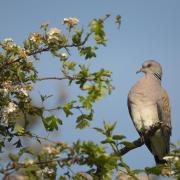Now that harvest is behind us, regular visitors to the countryside with a keen eye for detail might have noticed that a few changes have crept into the landscape in recent years post-harvest
Focus on Kent country life
Now that harvest is behind us, regular visitors to the countryside with a keen eye for detail might have noticed that a few changes have crept into the landscape in recent years post-harvest
Since the 1970s the harvest of many arable crops has been followed soon after by ploughing and the drilling (or sowing) of next year’s crop, leaving bare, tilled earth until the seed germinates. There is an alternative approach taken by many farmers, however. The evidence of this is fields which are left for the winter with the stubble of the harvested crop. A ploughed field is such a familiar sight at this time of year that it might appear that an unploughed field has been abandoned, particularly as the weeds start to grow.
Far from it. With encouragement from agri-environment schemes which contribute to (but, I would add, don’t cover) the costs of the non-food producing activities which farmers undertake to maintain the landscape, many farmers deliberately leave arable fields to become what could be described as the biggest and best bird-table imaginable.
In addition to the spilled grain left from harvest, the broadleaf weeds which flourish in the damp and relatively mild conditions of the autumn generate an excellent avian protein source for winter when they go to seed, as well as providing cover for insects on which birds can feed.
Sowing in spring rather than winter
There will still be a harvest next year from fields which have been left uncultivated during the winter, but the farmer has to sow different varieties – spring wheat rather than winter wheat, for example.
The price farmers pay is that the yield from crops sown in the spring tends to be lower than from those sown in the winter and cultivation can be more difficult after a wet winter. But the benefits for our bird population are considerable.
A further advantage of over-wintered stubbles for bird-life is that during the critical period from March to June the spring-sown crops have not yet engulfed fields to such an extent as to discourage ground-nesting birds.
Winter-sown varieties, by contrast, tend to be too advanced by the spring to encourage nesting of Kent’s downland species such as skylarks, corn buntings and lapwings, which prefer a more open crop canopy. Grey partridge is another species which is helped to flourish by over-wintered stubbles in this part of the world.
Kent’s diverse farming mix
Such bird-friendly measures are not equally suitable for all farming situations and agriculture must be financially viable like any business enterprise. Remember, too, that over-wintered stubbles are only a cereals option.
Kent has an unusually diverse mixture of farming, because of its varied landscapes, from downland to marsh, meaning the county produces everything from strawberries to wheat. If you are producing a root crop such as potatoes, then by definition you can’t leave it in the ground. In the absence of a root structure to hold the soil together after harvest, it is unwise to leave it uncultivated, as there is a high risk of erosion.
There are of course other options for farmers to encourage wildlife, such as leaving headlands and awkward corners uncultivated. Equally, you might see plots of fallow land within a field, which are almost certainly an environmental measure.
Farmers are being encouraged to take such measures through the Campaign for the Farmed Environment, to which I have referred in previous articles. This is an industry led initiative to conserve our flora and fauna without the arbitrary imposition of compulsory set-aside.
CFE encourages farmers to go a step beyond their existing commitment to wildlife, so this is very much about enhancing the environment, rather than just maintaining the status quo. As the campaign gathers pace, over-wintered stubbles and other wildlife-friendly measures should become an ever-more familiar sight.


























